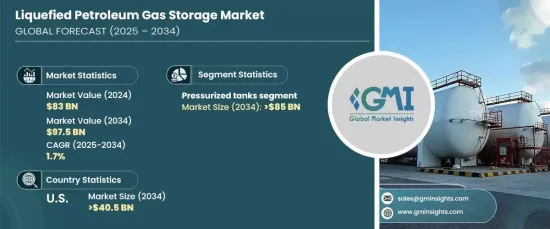 |
市場調查報告書
商品編碼
1666949
液化石油氣儲存市場機會、成長動力、產業趨勢分析及 2025 - 2034 年預測Liquefied Petroleum Gas Storage Market Opportunity, Growth Drivers, Industry Trend Analysis, and Forecast 2025 - 2034 |
||||||
2024 年全球液化石油氣儲存市場價值為 830 億美元,預計 2025 年至 2034 年期間將以 1.7% 的複合年成長率穩步成長。隨著世界各國政府推動擴大液化石油氣的使用,已推出各種措施來提高其供應,進一步促進市場擴張。這些努力以及人們對環境永續性的日益關注,大大推動了液化石油氣儲存市場的發展。

此外,政府正在執行更嚴格的法規和安全協議,從而導致對更先進的液化石油氣儲存解決方案的投資。政府和私營部門都在投資最先進的儲存技術,整合洩漏檢測系統和壓力監測等安全功能,從而進一步加強市場。人們對能源效率、安全性和永續性的日益關注,正在促進旨在滿足日益成長的液化石油氣需求的創新儲存技術的發展。
| 市場範圍 | |
|---|---|
| 起始年份 | 2024 |
| 預測年份 | 2025-2034 |
| 起始值 | 830億美元 |
| 預測值 | 975億美元 |
| 複合年成長率 | 1.7% |
預計到 2034 年,壓力罐市場的規模將超過 850 億美元。加壓罐能夠在緊湊的空間內有效地容納大量液化石油氣,非常適合住宅和工業用途。它們的適應性,加上改進的耐腐蝕材料、絕緣和整合監控系統等新技術,將在未來幾年推動這一領域的成長。
在美國,到2034年液化石油氣儲存市場規模預計將超過405億美元。此外,向更清潔能源的轉變擴大了液化石油氣在住宅烹飪、暖氣和工業領域的使用,從而增強了儲存和分配系統。智慧監控和自動化系統在提高液化石油氣儲存的營運效率和安全性方面發揮重要作用。
政府為促進清潔能源和減少溫室氣體排放而實施的激勵措施、強制措施和政策持續影響市場。這些法規提供了額外的成長機會,進一步支持了各地區液化石油氣儲存基礎設施的發展。
目錄
第 1 章:方法論與範圍
- 市場定義
- 基礎估算與計算
- 預測計算
- 資料來源
- 基本的
- 次要
- 有薪資的
- 民眾
第 2 章:執行摘要
第 3 章:產業洞察
- 產業生態系統分析
- 監管格局
- 產業衝擊力
- 成長動力
- 產業陷阱與挑戰
- 成長潛力分析
- 波特的分析
- 供應商的議價能力
- 買家的議價能力
- 新進入者的威脅
- 替代品的威脅
- PESTEL 分析
第4章:競爭格局
- 介紹
- 戰略儀表板
- 創新與永續發展格局
第 5 章:市場規模及預測:依儲存類型,2021 – 2034 年
- 主要趨勢
- 加壓罐
- 冷藏罐
第6章:市場規模及預測:按地區,2021 – 2034 年
- 主要趨勢
- 北美洲
- 美國
- 加拿大
- 歐洲
- 西班牙
- 俄羅斯
- 英國
- 義大利
- 法國
- 德國
- 亞太地區
- 中國
- 日本
- 韓國
- 印度
- 澳洲
- 中東和非洲
- 沙烏地阿拉伯
- 阿拉伯聯合大公國
- 土耳其
- 南非
- 摩洛哥
- 拉丁美洲
- 巴西
- 墨西哥
- 阿根廷
第7章:公司簡介
- AmeriGas
- China Petroleum
- CIMC ENRIC
- CLW Group
- Emirates Gas
- Energy Transfer
- Flogas
- Modern Welding
- Omera
- Oiltanking
- Pertamina
- Petredec
- Royal Vopak
- TotalEnergies
- TransTech Energy
- Vitol
The Global Liquefied Petroleum Gas Storage Market was valued at USD 83 billion in 2024 and is expected to grow steadily at a CAGR of 1.7% from 2025 to 2034. Rapid urbanization and the increasing demand for clean, efficient fuel alternatives to minimize environmental impact are key drivers propelling the market forward. As governments worldwide push for broader access to LPG, various initiatives have been introduced to enhance its availability, further boosting market expansion. These efforts, along with rising concerns over environmental sustainability, have given a significant push to the LPG storage market.

Additionally, governments are enforcing stricter regulations and safety protocols, leading to investments in more advanced LPG storage solutions. Both government and private sectors are investing in state-of-the-art storage technologies, integrating safety features such as leak detection systems and pressure monitoring, which further strengthens the market. The growing focus on energy efficiency, safety, and sustainability is fostering the development of innovative storage technologies designed to meet the growing demand for LPG.
| Market Scope | |
|---|---|
| Start Year | 2024 |
| Forecast Year | 2025-2034 |
| Start Value | $83 Billion |
| Forecast Value | $97.5 Billion |
| CAGR | 1.7% |
The pressurized tanks segment is predicted to surpass USD 85 billion by 2034. These tanks play a crucial role in the safe storage and distribution of LPG, as they maintain the gas in its liquid state under pressure, offering high energy density and efficient transport options. Pressurized tanks are highly effective in holding large quantities of LPG in compact spaces, making them ideal for both residential and industrial use. Their adaptability, combined with new technologies such as improved corrosion-resistant materials, insulation, and integrated monitoring systems, will drive the growth of this segment in the coming years.
In the United States, the LPG storage market is projected to exceed USD 40.5 billion by 2034. The country's abundance of shale gas, coupled with a rising demand for LPG driven by population growth and higher energy consumption, is fostering increased LPG production. Moreover, the shift toward cleaner energy sources has expanded the use of LPG across residential cooking, heating, and industrial sectors, leading to enhanced storage and distribution systems. Smart monitoring and automation systems are playing an essential role in improving operational efficiency and safety in LPG storage.
The implementation of government incentives, mandates, and policies promoting cleaner energy and reducing greenhouse gas emissions continues to shape the market. These regulations are providing additional opportunities for growth, further supporting the development of LPG storage infrastructure across various regions.
Table of Contents
Chapter 1 Methodology & Scope
- 1.1 Market definitions
- 1.2 Base estimates & calculations
- 1.3 Forecast calculation
- 1.4 Data sources
- 1.4.1 Primary
- 1.4.2 Secondary
- 1.4.2.1 Paid
- 1.4.2.2 Public
Chapter 2 Executive Summary
- 2.1 Industry synopsis, 2021 - 2034
Chapter 3 Industry Insights
- 3.1 Industry ecosystem analysis
- 3.2 Regulatory landscape
- 3.3 Industry impact forces
- 3.3.1 Growth drivers
- 3.3.2 Industry pitfalls & challenges
- 3.4 Growth potential analysis
- 3.5 Porter's analysis
- 3.5.1 Bargaining power of suppliers
- 3.5.2 Bargaining power of buyers
- 3.5.3 Threat of new entrants
- 3.5.4 Threat of substitutes
- 3.6 PESTEL analysis
Chapter 4 Competitive Landscape, 2024
- 4.1 Introduction
- 4.2 Strategic dashboard
- 4.3 Innovation & sustainability landscape
Chapter 5 Market Size and Forecast, By Storage Type, 2021 – 2034 (USD Billion, Million Barrels)
- 5.1 Key trends
- 5.2 Pressurized tanks
- 5.3 Refrigerated tanks
Chapter 6 Market Size and Forecast, By Region, 2021 – 2034 (USD Billion, Million Barrels)
- 6.1 Key trends
- 6.2 North America
- 6.2.1 U.S.
- 6.2.2 Canada
- 6.3 Europe
- 6.3.1 Spain
- 6.3.2 Russia
- 6.3.3 UK
- 6.3.4 Italy
- 6.3.5 France
- 6.3.6 Germany
- 6.4 Asia Pacific
- 6.4.1 China
- 6.4.2 Japan
- 6.4.3 South Korea
- 6.4.4 India
- 6.4.5 Australia
- 6.5 Middle East & Africa
- 6.5.1 Saudi Arabia
- 6.5.2 UAE
- 6.5.3 Turkey
- 6.5.4 South Africa
- 6.5.5 Morocco
- 6.6 Latin America
- 6.6.1 Brazil
- 6.6.2 Mexico
- 6.6.3 Argentina
Chapter 7 Company Profiles
- 7.1 AmeriGas
- 7.2 China Petroleum
- 7.3 CIMC ENRIC
- 7.4 CLW Group
- 7.5 Emirates Gas
- 7.6 Energy Transfer
- 7.7 Flogas
- 7.8 Modern Welding
- 7.9 Omera
- 7.10 Oiltanking
- 7.11 Pertamina
- 7.12 Petredec
- 7.13 Royal Vopak
- 7.14 TotalEnergies
- 7.15 TransTech Energy
- 7.16 Vitol











